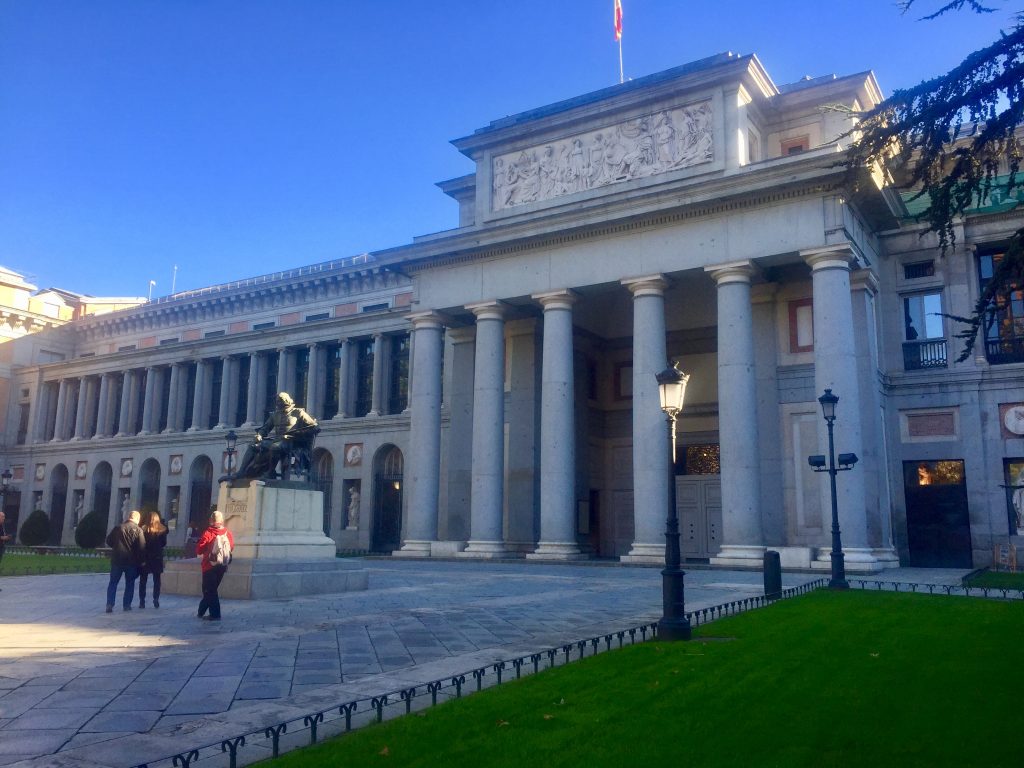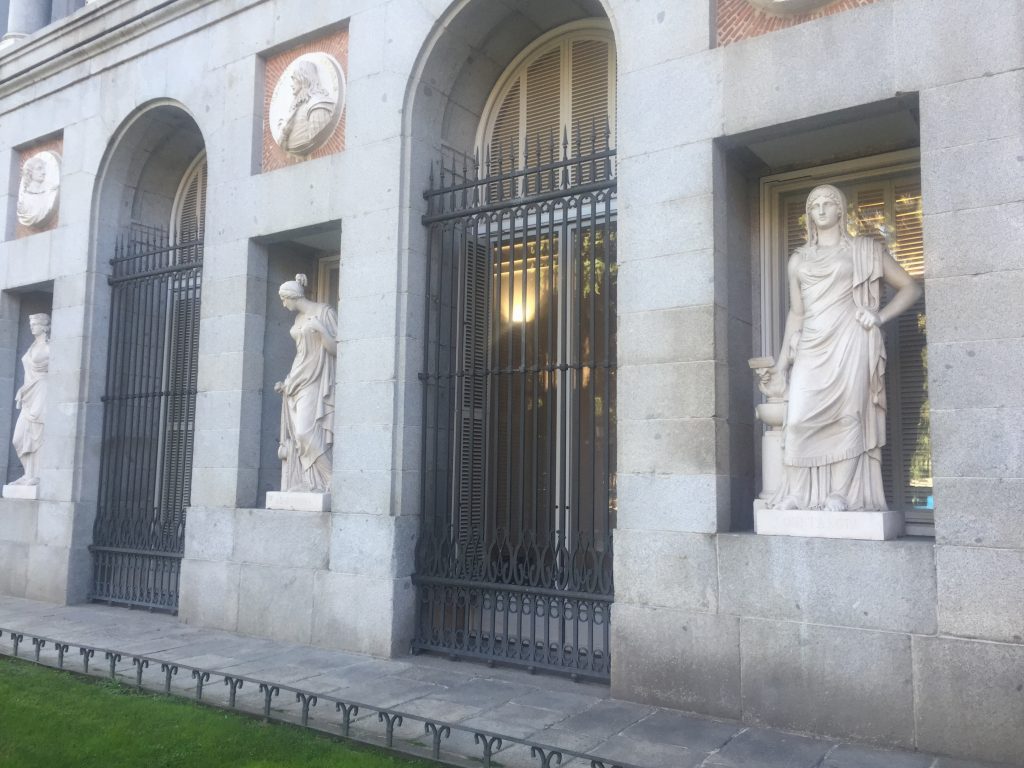The Prado Museum
The Prado museum in Madrid holds one of the two or three most important collections of European masters anywhere in the world. Painters and sculptors from the 12th to the 20th century are represented not only by well-known masterworks but also by sheer volume and scope of their work.
We spent an entire day in the Prado. Photos are not permitted once you enter the extensive facility, so all you’ll see is a few shots of the building exterior, which is impressive in itself.
I’m going to describe the experience by way of contrasting it to visiting the Reina Sofia. It’s probably a bit unfair, as the Reina is much smaller and focused on modern art, but each contains a major masterpiece (or several) that almost anyone in the world would recognize. In the Reina, it’s no contest–Picasso’s Guernica rules the roost and standing before it is a profound experience. An adjacent room contains a number of studies Picasso executed for Guernica, and they are at least as interesting and arresting. The Prado boasts more masterpieces–Bosch’s Garden of Earthly Delights, Goya’s May 2nd (and 3rd), Teipolo’s Immaculate Conception, for example–and the painting that is widely considered the best painting in the world: Velasquez’ Las Meninas. I’ll have to admit that I didn’t see what critics and artists saw in Las Meninas until I stood before it. Well, not exactly before it. The farther away you move, the more depth, perspective, and clever tricks you see. I’m now inclined to agree with the critics on this one. (Girl with a Pearl Earring is still my favorite painting, though.)
But back to the experience. The Reina was like floating in a comfortable stream. I felt as if I were participating in a story. I think this is largely due to the expert curation of the works, and I’m sure the smaller size of the collection was a factor as well. The Prado was more like channel surfing. Sometimes the works were displayed chronologically; other times they followed a specific theme (e.g., the Immaculate Conception). Some rooms were devoted to specific artists, sometime it took several rooms to house the collection (e.g., Goya and Ruebens). But then stray works by Goya would show up elsewhere and make you wonder why they were placed in that particular part of the museum. I’m sure there’s a grand logic to it all, but to a first time visitor it seemed random at times. This is not to say it wasn’t a glorious experience. It was, but I left feeling as if I needed to get away and process things. With the Reina, I left satisfied.
Best surprises in the Prado.
- Torreggiani’s marble bust “Isabel II Veiled.” I’ve seen and admired photos of this work, but seeing it up close is impressive.
- Las Meninas. See above.
- Watching Goya’s descent into madness.
- Quinten Matsys’ paintings. I need to know more.
- Gisbert’s “Execution of Torrijos and his Companions.” So much humanity and emotion in the faces of the men waiting to be shot.
- Goya’s “Two Cats Fighting.” Who knew?
- Beuckelaer’s “The Market.” He was doing realistic scenes when most of his contemporaries were still using heavy religious symbolism.


5 thoughts on “The Prado Museum”
I’m impressed it meant so much to you, and it makes me realize once again how ignorant I am about “art.”
On the other hand, I couldn’t get out of there fast enough.
Can’t wait to see where y’all go tomorrow!
It’s overwhelming on so many levels. There are only so many portraits of Spanish noblemen or versions of the Annunciation that you can absorb. (Portraiture is not generally in my wheelhouse anyway.) So there were some rooms that got only cursory attention as we wandered through. But then you come across something that reaches out and grabs you and you can sit and contemplate for a bit.
It also helps a lot to see the paintings in their historical and social context. Guernica is a great example of that. It showed the world what was happening under Franco in a way that spoke to almost everyone on a visceral level.
Anyway, it’s not for everyone, to be sure.
I’m looking forward to our visit to the Prado next week. I’m especially excited that the very first exhibition devoted to a female painter (Clara Peeters) will be on during our visit. While I’m not excited in particular for still life, I still think it is a major milestone!
https://www.museodelprado.es/en/whats-on/new/the-museo-del-prado-presents-the-first-exhibition/e5fd751b-67e8-48db-bb5a-bf8bfddcc1f5
Cheers,
Jennifer
There were three places that were “must-sees” on our visit to Spain, and the Prado was one of those. (La Mezquita and Alhambra were the others. If you have the opportunity to visit Córdoba on your trip, don’t miss La Mezquita.)
The Prado is just overwhelming. I’d suggest picking up one of their printed guides, sitting down, and marking the works you want to see most.
The Reina Sofia and the Thyssen are also highly recommended. Each is a short walk from the Prado…
I discovered an intriguing female painter in the Reina Sofia–ángeles Santos, whose story is as fascinating as her painting. She essentially came out of nowhere at age 18, had a breakdown…well, it’s worth some time reading about her and examining her very limited catalog.